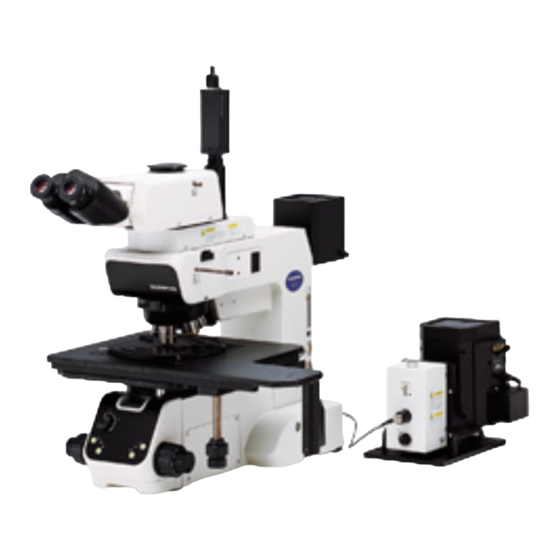Olympus U-UVF248 Instructions Manual - Page 7
Browse online or download pdf Instructions Manual for Microscope Olympus U-UVF248. Olympus U-UVF248 24 pages. 248 nm uv microscope unit

2
Getting Ready
1. This manual pertains only to the information related to the UV microscopy unit. Please also read the instruction manuals
for the BX2/MX microscope and associated modules to obtain understanding on the general operating methods.
2. The operating temperature range when a UV objective is used is from 18 to 28°C (64 to 82°F). Outside this temperature
range, the UV objective may be unable to exhibit its full performance.
3. To perform UV observation, engage a UV-dedicated objective in the light path and set the light path of the reflected light
illuminator to the DF position.
If UV rays irradiates on an objective for visible light observation, the performance of the objective will deteriorate.
4. Since UV observation employs high magnification and high resolution, it is affected easily by oscillations. It is therefore
recommended to use an anti-vibration bench.
5. The 248 nm UV rays damage the resist so the observation period should be reduced as short as possible.
6. A very small black dot may be produced at the center of the UV light guide in the initial period after start of UV irradiation.
This dot will disappear spontaneously as the irradiation is continued.
7. Due to the characteristics of the UV light guide, flickering or unevenness in observation images may occur if the light
guide is wound tightly or moved during observation.
8. When not using the microscope, be sure set the main switch to "
cooled down sufficiently, be sure to cover it with the dust cover and store in a place with low humidity where moth or rust
hardly occurs.
9. When disposing of the microscope, check the regulations and rules of your local government and be sure to observe
them. The used mercury/xenon burner should be disposed of as an industrial waste. If you cannot dispose of it by
yourself, contact Olympus.
3
Maintenance and Storage
1. To clean the lenses and other glass components, simply blow dirty away using a commercially available blower and wipe
gently using a piece of cleaning paper (or clean gauze).
If a lens is stained with fingerprints or oil smudges, wipe it gauze slightly moistened with commercially available absolute
alcohol.
Since the absolute alcohol is highly flammable, it must be handled carefully.
Be sure to keep it away from open flames or potential sources of electrical sparks --- for example, electrical
equipment that is being switched on or off.
Also remember to always use it only in a well-ventilated room.
2. If any part of the equipment (other than glass components) gets dirty, wipe it with a clean cloth.
If the part is extremely dirty, do not attempt to use organic solvents to clean it; instead, use a soft, lint-free cloth slightly
moistened with a diluted neutral detergent.
3. Never disassemble any part other than instructed of the unit. This could result in malfunctions, reduced performance or
UV leak.
4
Caution
If the microscope system is used in a manner not specified by this manual, the safety of the user may be imperiled. In
addition, the equipment may also be damaged. Always use the equipment as outlined in this instruction manual.
The following symbols are used to set off text in this instruction manual.
: Indicates that failure to follow the instructions in the warning could result in bodily harm to the
user and/or damage to equipment (including objects in the vicinity of the equipment).
# : Indicates that failure to follow the instructions could result in damage to equipment.
} : Indicates commentary (for ease of operation and maintenance).
" (OFF). After confirming that the microscope has
U-UVF248
4
